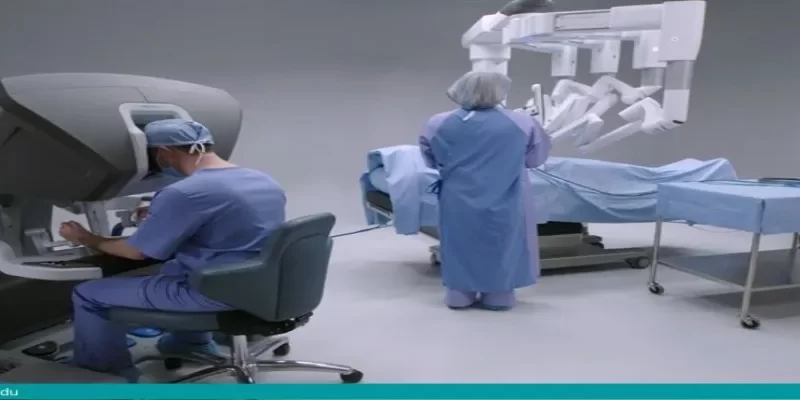Robotic surgery is not conducted by robots, despite popular belief. Instead, the surgeon maintains complete control over the robotic arms at all times. The robot acts as a tool and can be considered a sort of helper to the surgeon, hence the term “robotic-assisted surgery.“
Doctors use robotic surgery to remove tumors that are hard to reach, minimize operation timelines, and reduce side effects for people who have cancer and require surgery for treatment. These instruments first appeared in the late 1980s and are now becoming more widespread in operating rooms.
Dr. Sandeep Nayak, an accomplished surgical oncologist in Bangalore, India, says that robotic surgery may be the most sophisticated and advanced medical technology available today.
How is a robotic surgery conducted?
Robotic surgery includes a camera along with tiny surgical tools affixed to robotic arms. The robotic arms are controlled by an exceptionally skilled surgeon via a display monitor, usually located in the same area as the surgical table.
However, the viewing screen can also be placed far away, enabling surgeons to undertake the telesurgery from different locations. The screen is part of a console, allowing surgeons to do procedures while seated and viewing a magnified three-dimensional representation of the patient’s surgery site.
Bangalore’s renowned surgical oncologist, Dr. Sandeep Nayak, prefers conducting robotic cancer surgery because it allows for better vision, which aids in preserving nerves and other vital structures during radical procedures.
What are the benefits of robotic surgery?
Robotic devices are frequently used in minimally invasive or laparoscopic surgeries. Small incisions are used in these surgeries, as the name implies.
The following are just a few of the many advantages of robotic surgery:
- Complication risk is lower
- It enables cancerous tissue to be accurately removed
- Reduced discomfort and pain
- Reduced discomfort and pain
- Recovery time is reduced
- Allows you to resume normal activities faster
- Incisions are smaller, and scarring is minimal
- Transfusions and blood loss are reduced
- Increasing the number of cancer survivors
- Robotic devices have improved dexterity (in comparison with a surgeon’s hand), allowing access to difficult-to-reach areas
- The magnification of the surgical site on the surgeon’s monitor allows for better visualization of the area to be operated on
- The surgeon is less tired
- Hand tremor among surgeons is no longer a problem (which commonly occurs during extended surgical procedures)
Dr. Sandeep Nayak, among the best oncologists in India, says that people are becoming increasingly aware of robotic cancer surgery due to its various benefits.
Who is not a good candidate for robotic surgery?
There are a variety of reasons why robotic surgery may not be a viable choice, including:
- Obesity:
The surgeon’s view of the operative site would be obstructed by fat tissue. Obesity does not automatically disqualify a person from robotic-assisted surgery; it is dependent on the individual’s anatomy, the type of cancer, and other conditions.

- Specific medical conditions or surgical procedures:
Many problems are beyond the scope of robotic-assisted surgery, like reconstructive plastic microsurgery. Most robotic surgery instruments are now far too large and were not designed to do microsurgery on delicate tissues involved in most reconstructive treatments. Furthermore, the magnification for the surgeon’s view employing robotic aid technology is insufficient for proper viewing in microsurgery. The technology needed to undertake reconstructive plastic microsurgery has yet to be developed.
- Contraindication or a specific risk:
These are instances in which there is a significant risk of injury.
- Comorbidity:
Individuals with multiple (more than one) medical conditions.
Please do not hesitate to speak with the highly experienced oncologist Dr. Sandeep Nayak if you are not sure whether you are a good candidate for robotic surgery.
What are the post-robotic surgery instructions?
Although recovery from robotic surgery is usually faster and there is less pain and discomfort than conventional surgery, you will have to restrict yourself from some activities. Post-operative guidelines may include:
- Your surgeon may advise you to avoid lifting heavy objects or straining yourself until your healthcare professional permits you to resume normal activities.
- Your surgeon may advise you to refrain from driving for at least a week.
- Follow your surgeon’s directions for pain medication and other post-operative procedures.
- Contact your healthcare provider if your pain intensifies and is not alleviated by pain medicine) or if you have bleeding, nausea, and vomiting.
- If you notice pus or redness at any surgery site, you should call your healthcare provider immediately. This could signal that an infection has begun.
What are conditions generally treated with robotic surgery?
Robotic cancer procedures are typically used to operate on difficult-to-reach locations requiring extreme precision.
The acclaimed surgical oncologist, Dr. Sandeep Nayak, employs the robotic-assisted technology to execute a wide range of surgical procedures, including:
- Pancreatic surgery
- Liver tumors
- Tumors of the throat or tongue, thyroid cancer
- Colon and rectal cancer
- Urological surgeries like a section of kidney, prostate cancer, etc
- Gynecologic surgery such as ovarian, uterus/cervical, etc
Conclusion

Having cancer can be an extremely exhausting experience, and going through the various treatments and post-surgery side-effects can be painfully challenging to deal with. Fortunately, with robotic surgery, the recovery time is faster and it causes minimal discomfort.
If you or a loved one is considering getting robotic-assisted surgery for your medical condition, please visit Dr. Sandeep Nayak.
Robotic surgery devices are noted for having a better range of motion and dexterity than standard minimally invasive or laparoscopic surgery devices. These devices enable the surgeons to operate on areas of the body that are difficult to reach and have a closer look at areas that are difficult to view.
Dr. Nayak is a top-notch oncologist, and with over 15 years of expertise, he is one of the preferred surgeons people go to when they require robotic cancer surgery in Bangalore, India.


